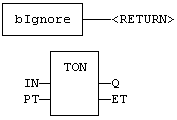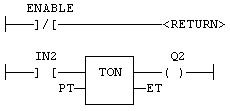RETURN RET RETC RETNC RETCN
Remarks
- When used within an action block of a SFC step, the RETURN statement jumps to the end of the action block.
FBD Language Example
- The return statement is represented by the <RETURN> symbol.
- The input of the symbol must be connected to a valid Boolean signal.
- The jump is performed only if the input is TRUE.
In this example, the TON block will not be called if bIgnore is TRUE.

FFLD Language Example
- The <RETURN> symbol is used as a coil at the end of a rung.
- The jump is performed only if the rung state is TRUE.
In this example, all the networks above 5 are skipped if ENABLE is FALSE.

IL Language Example
These are the meanings of possible instructions:
- RET Jump to the end always.
- RETC Jump to the end if the current result is TRUE.
- RETNC Jump to the end if the current result is FALSE.
- RETCN Same as RETNC.
Start: FFLD IN1
RETC (* Jump to the end if IN1 is TRUE *)
FFLD IN2 (* these instructions are not executed *)
ST Q2 (* if IN1 is TRUE *)
RET (* Jump to the end unconditionally *)
FFLD IN3 (* these instructions are never executed *)
ST Q3
ST Language Example
IF NOT bEnable THEN
RETURN;
END_IF;
(* the rest of the program is not executed if bEnable is FALSE *)
See Also






